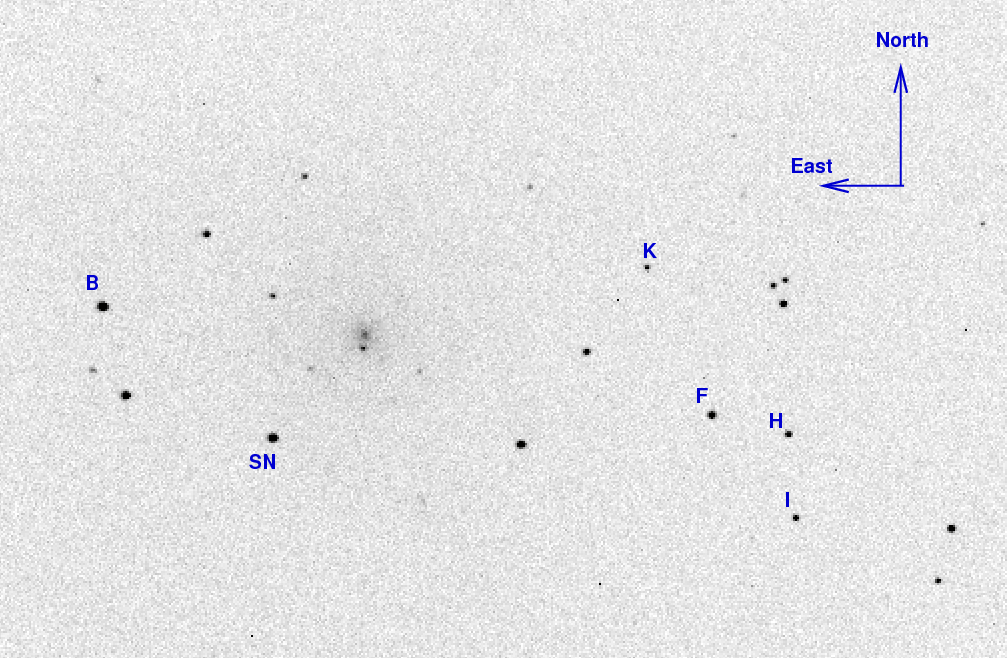
On the night of Sep 18/19, 2013, I observed SN 2013ej in M74 and the newly discovered CV MASTER OT J004527.52+503213.8. Conditions were fair: clear skies, but a bright moon close to the SN.
The main setup was:
Notes from the night
SN 2013ej is a Type II supernova in the relatively nearby galaxy M74. It was discovered by the KAIT group about one week before maximum light. Here's a chart showing the galaxy, the SN, and some reference stars:

The reference stars marked above have magnitudes in AAVSO chart 12459CA, as follows:
letter B sigB V sigV R sigR I sigI B 13.012 0.019 12.510 0.019 12.154 0.019 11.834 0.019 F 13.848 0.026 13.065 0.022 12.622 0.025 12.152 0.027 H 14.338 0.029 13.692 0.024 13.329 0.029 12.964 0.030 I 14.832 0.027 13.912 0.023 13.416 0.026 12.939 0.030 K 15.192 0.034 14.613 0.027 14.275 0.034 13.915 0.036
I took 30-second guided images in VRI, but unguided images in B. After discarding the bad images, I was left with 12, 9, 7, and 8 images in B, V, R, and I, respectively.
Using aperture photometry with a radius of 4 pixels (radius of 7.4 arcsec), I measured the instrumental magnitudes of a number of reference stars and the target. Following the procedures outlined by Kent Honeycutt's article on inhomogeneous ensemble photometry, I used all stars available in each image to define a reference frame, and measured each star against this frame. I used the AAVSO magnitudes, plus color terms to convert the ensemble instrumental magnitudes to the standard Johnson-Cousins BVRI scale.
In addition to extracting instrumental magnitudes from each individual image of the SN, I also co-added (using a median technique) all the good images in each filter to create a single image with higher signal-to-noise. Below is a comparison of the results derived from individual images to those derived from the median image:
median - individual B V R I ------------------------------------------------------------------------- Sep 11 UT -0.098 -0.016 -0.003 -0.002 Sep 18 UT 0.059 -0.005 0.009 -0.013 Sep 19 UT -0.078 0.015 -0.007 0.003 -------------------------------------------------------------------------
The B-band measurements from individual images are poor, and even in the median-combined images, the SN is growing very faint. If I can't figure out how to expose for more than 30 seconds, I may have to stop monitoring it in B soon.
I will report the results based on the median images below.
Results from this evening are:
filter mag mag_uncert Julian Date B = 14.889 +/- 0.048 (ens 0.046 zp 0.013) 2456554.63877 V = 13.450 +/- 0.039 (ens 0.018 zp 0.035) 2456554.62550 R = 12.909 +/- 0.016 (ens 0.014 zp 0.007) 2456554.61982 I = 12.627 +/- 0.021 (ens 0.020 zp 0.008) 2456554.63183
The uncertainties here are (except for B) roughly equally distributed between extracting the instrumental magnitudes and transforming the instrumental magnitudes to the standard scale.
Grab the text file below for all the RIT measurements of SN 2013ej. All these values have been recomputed with the new color terms of UT 2013 Aug 05.
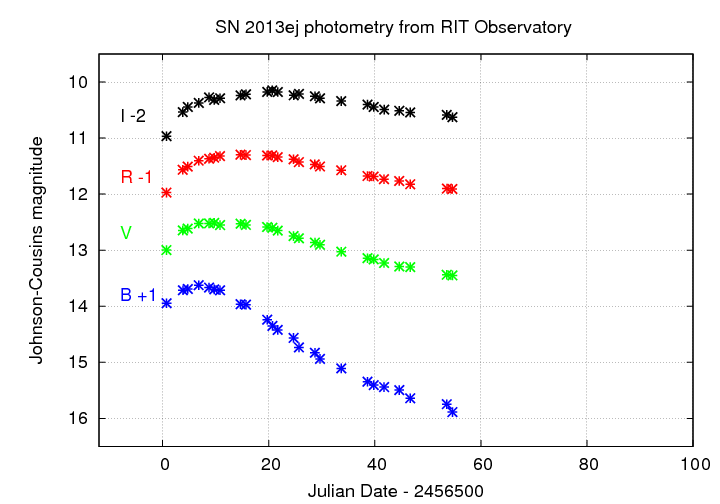
MASTER OT J004527.52+503213.8 is a newly discovered cataclysmic variable. You can read more about it in Astronomer's Telegram number 5399.
Here's a chart based on one of my images:
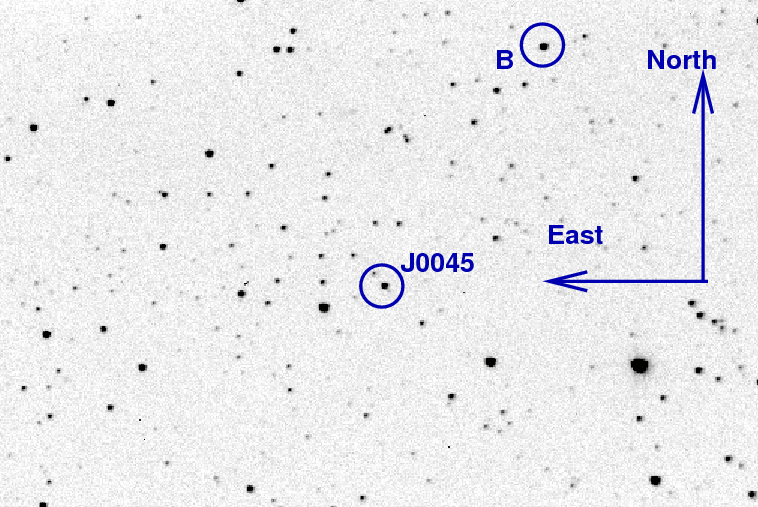
The reference star marked above have magnitudes in AAVSO chart 12683RZT, as follows:
letter B sigB V sigV R sigR I sigI B 13.655 0.067 13.036 0.041 12.670 0.088 12.326 0.118
I took 30-second guided images in the "clear" filter, which means unfiltered, but I'll shift my measurements to match the V-band.
Using aperture photometry with a radius of 4 pixels (radius of 7.4 arcsec), I measured the instrumental magnitudes of a number of reference stars and the target. Following the procedures outlined by Kent Honeycutt's article on inhomogeneous ensemble photometry, I used all stars available in each image to define a reference frame, and measured each star against this frame. I used the AAVSO magnitudes, to convert the ensemble instrumental magnitudes to the standard Johnson-Cousins BVRI scale.
The graph below shows the magnitude offset required to place each image into the ensemble solution. It reveals a good night: no jumps due to clouds. The drop at the very beginning is due to a movement of the dome slit.
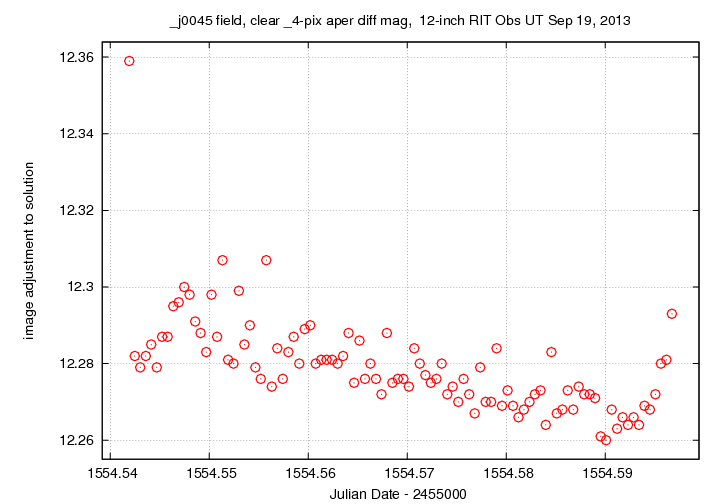
Below is the uncertainty in instrumental magnitudes as a function of instrumental magnitudes, from the ensemble solution. The target is the bright star with elevated scatter:
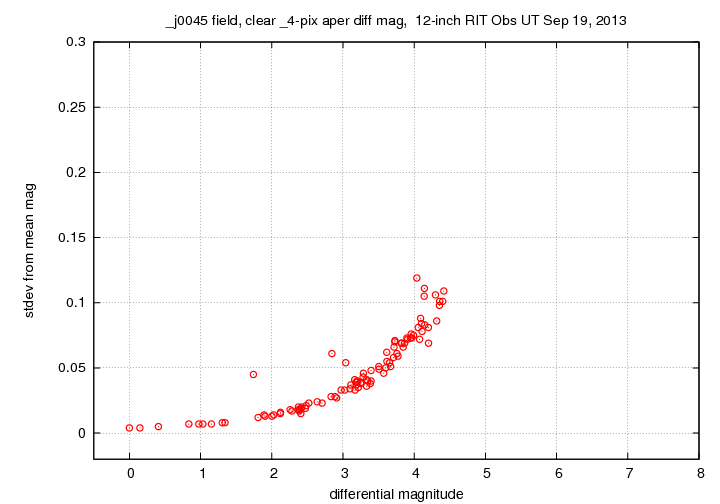
Light curves for the variable and several nearby stars are shown below. The variable is denoted by green crosses. It went through _almost_ one cycle during my measurements.
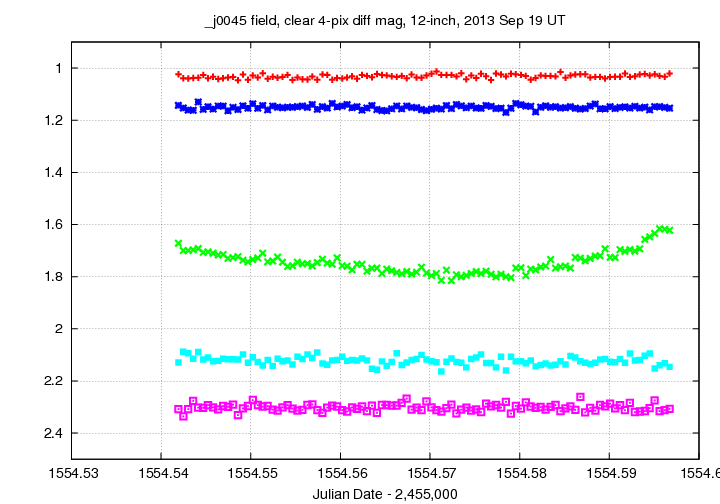
Grab the text file below for all the RIT measurements of MASTER OT J004527.52+503213.8 from the night. I show the first few lines of the file for format:
# Measurements of J004527.52+503213.8 made at RIT Obs, Sep 19, 2013 UT, # in good conditions, # by Michael Richmond, using 12-inch Meade and SBIG ST-8E CCD. # Exposures 30 seconds long, no filter. # Tabulated times are midexposure (FITS header time - half exposure length) # and accurate only to +/- 1 second (??). # 'mag' is a differential magnitude based on ensemble photometry # using a circular aperture of radius 7.4 arcseconds. # which has been shifted so UCAC4 704-005807 has mag=13.036 # which is its V-band magnitude according to AAVSO. # # UT_day JD HJD mag uncert Sep19.04193 2456554.54193 2456554.54521 13.403 0.013 Sep19.04248 2456554.54248 2456554.54576 13.431 0.013 Sep19.04303 2456554.54303 2456554.54631 13.431 0.013 Sep19.04359 2456554.54359 2456554.54687 13.428 0.013
Last modified 09/21/2013 by MWR.